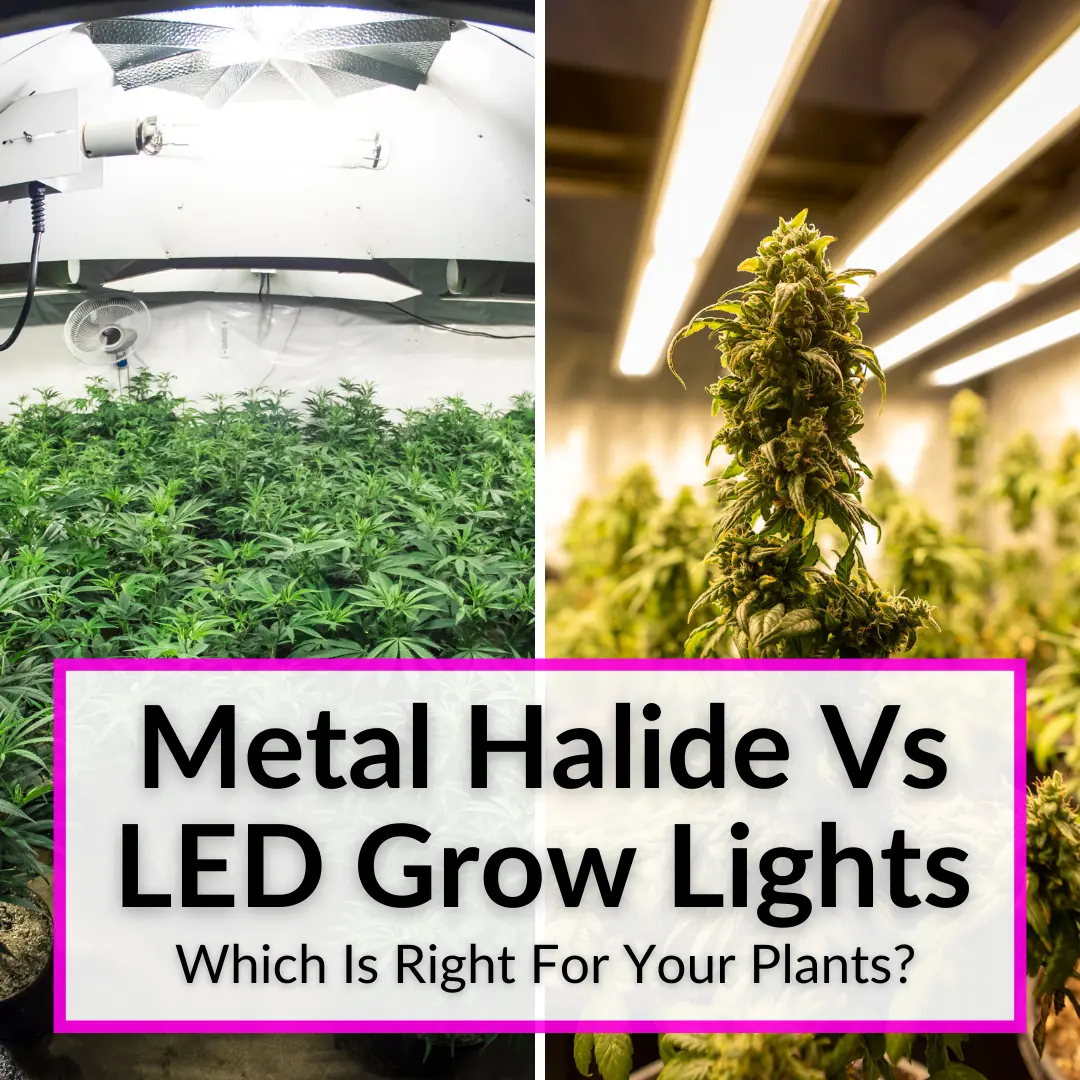 Indoor growers have a few options when it comes to plant lighting.
Indoor growers have a few options when it comes to plant lighting.
LED grow lights, HID grow lights, and fluorescent grow lights are the top choices. Metal halide lights are a type of HID lighting.
As such, they have similar advantages and disadvantages, though MH does have one unique feature.
It has to do with the spectrum.
We will get into that below, in our full comparison of metal halide vs LED grow lights.
Keep reading to find out how these two popular types of grow lights stack up. We will help you figure out which one is right for you and your plants (and your wallet).
Contents
- 1 Metal Halide Vs LED Grow Lights
- 1.1 Metal Halide Grow Lights
- 1.2 LED Grow Lights
- 1.3 Differences Between Metal Halide And LED Grow Lights
- 1.4 Similarities Between MH And LED Grow Lights
- 1.5 Advantages Of Metal Halide Grow Lights
- 1.6 Advantages Of LED Grow Lights
- 1.7 Reasons To Get Metal Halide Grow Lights
- 1.8 Reasons To Get LED Grow Lights
- 2 LED Grow Lights Vs Metal Halide: Final Thoughts
Metal Halide Vs LED Grow Lights
We will begin our comparison of LED and metal halide grow lights by looking at each type of lighting individually, before comparing them directly. We will finish with the advantages of each and help you figure out which type is best for you and your grow.
Metal Halide Grow Lights
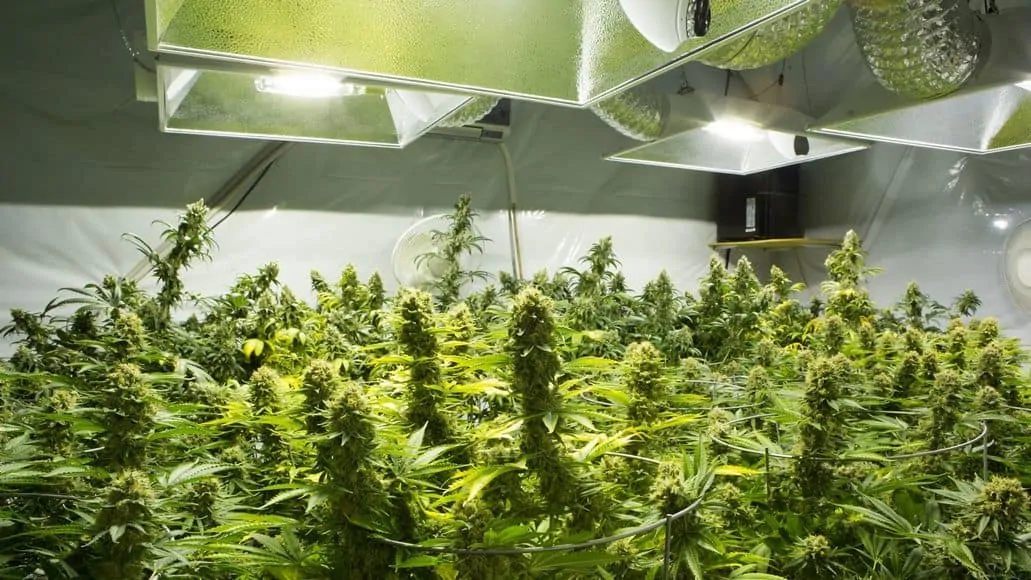
Metal Halide grow lights are a type of HID lamp that produce a lot of light within a broad spectrum, making them ideal for growing plants indoors.
They work by creating an electric arc between two electrodes in a quartz arc tube filled with a gaseous mixture of mercury and metal halides. The arc heats up the gas, causing the mercury and metal halide compounds to vaporize. The vaporized particles then collide with each other to produce light.
Metal Halide grow lights are relatively expensive to purchase and operate, and they produce a lot of heat, so it is important to ensure that they are properly ventilated. However, they are a powerful and effective way to grow plants indoors. They are not great for flowering plants, but excellent for vegging.
LED Grow Lights
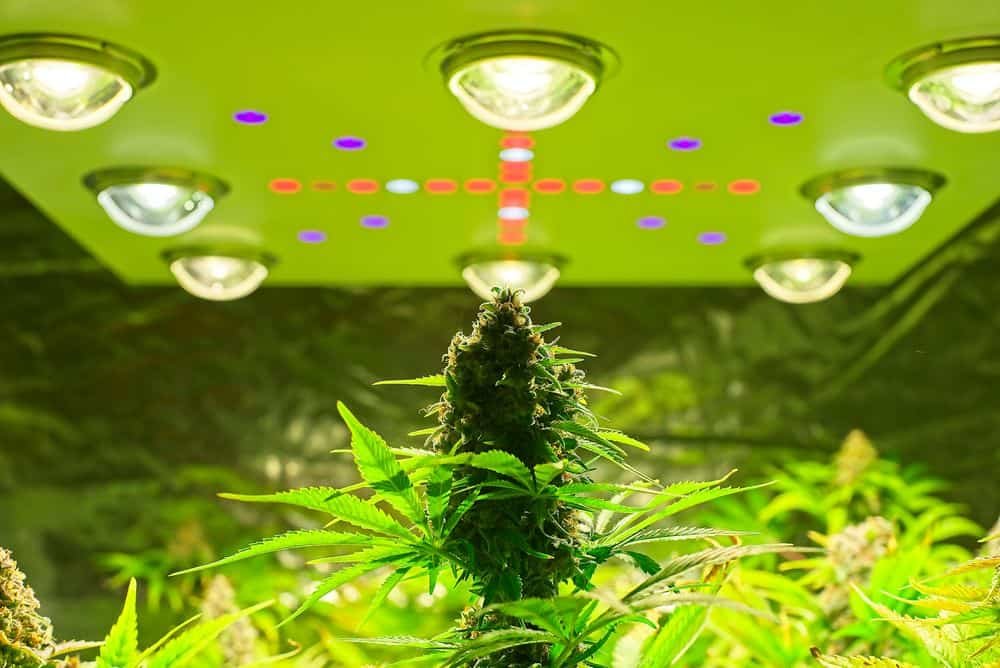
LED (light-emitting diode) grow lights are a type of solid-state lighting (SSL) lamp that also produce a lot of light within a broad spectrum, making them another good choice for growing plants indoors.
They work by converting electrical energy directly into light, without the need for an arc or a gaseous mixture.
LED grow lights are more expensive to purchase than traditional metal halide grow lights, but they are also more energy-efficient and produce less heat. This makes them a more cost-effective option in the long run, especially for growers who operate large indoor grow spaces.
Differences Between Metal Halide And LED Grow Lights
These two types of grow lights differ in a couple of key aspects. First, MH lights emit a fixed spectrum of light. It is a white light that includes both blue and red wavelengths, but that is much heavier on the blue.
This means MH lights can work for all stages of growth, but they are much more suitable for the vegetative stage of plant growth.
On the other hand, LED plant light manufacturers can completely customize the spectrum of LED grow light to emit specific wavelengths. This means that good LED grow lights emit a light spectrum that is perfectly tailored for the needs of plants.
Second, MH lights generate more heat, requiring additional cooling mechanisms. LEDs produce significantly less heat, reducing the risk of damage to plants.
Finally, LED grow diodes have a longer lifespan (no bulb changes for 5 to 10 years, or more) and lower energy consumption than MH lights. This results in lower maintenance and electricity costs over time.
Similarities Between MH And LED Grow Lights
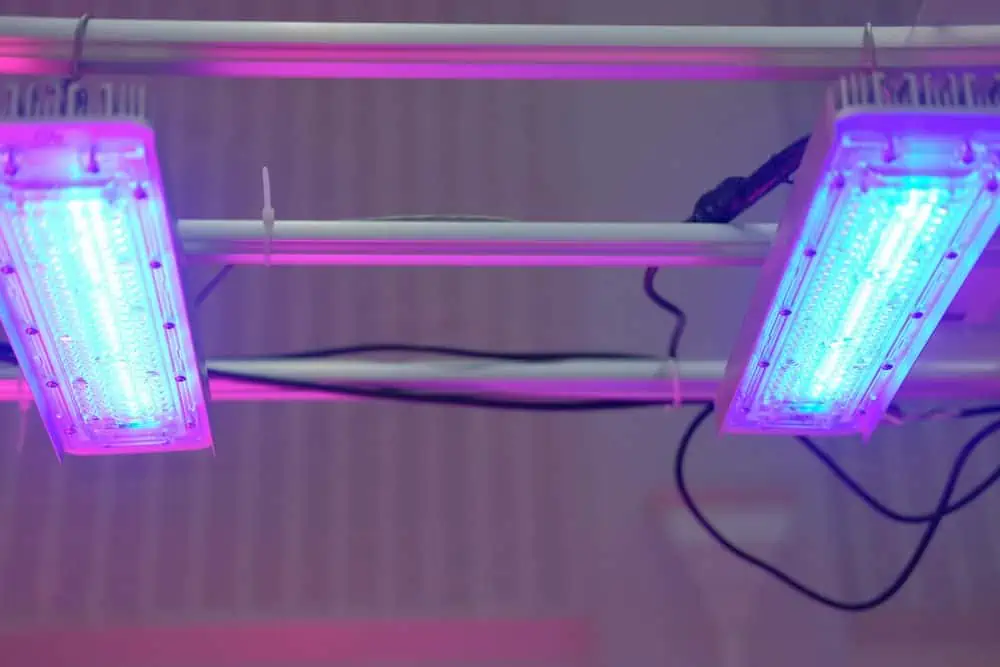
While MH and LED grow light have a few differences, they also have a few traits in common. One similarity between the two is their ability to provide the necessary light spectrum for optimal plant growth.
Both MH and LED lights emit a full-spectrum white light that includes a combination of blue and red light (along with other colors). Blue and red are essential for photosynthesis and promote healthy plant development.
Again, LED lights can have any spectrum, but we are assuming good quality LED grow lights that deliver a light spectrum specifically tailored for plants.
Of course, when it comes to flowering, the story is different. MH still works, but LED works far better. That is why growers who use HID lights tend to use MH lighting for the growth stage and HPS (heavier in red) for the flowering stage. But LEDs do both.
Additionally, both types of lights are energy-efficient compared to other lighting options, reducing electricity costs. But LED grow lights are far more efficient than MH. And MH and LED lights also have longer lifespans, requiring less frequent replacement than other options.
These similarities make both MH and LED grow lights valuable choices for indoor gardening enthusiasts. But these days, there is honestly no real reason to use MH over LED anymore, unless you simply do not have the funds to buy LED grow lights.
Advantages Of Metal Halide Grow Lights
Metal halide lights have a few advantages over other types of lights. But when you compare then to LED grow lights, they really only have one advantage: the lower initial cost.
Cost-Effective Initial Investment
Metal halide grow lights are generally more affordable than LED grow lights, making them a cost-effective option for growers on a budget. Of course, they will cost more to operate over the long run.
Wide Spectrum Of Light
Metal halide grow lights emit a broad spectrum of light, including both blue and red wavelengths, which are essential for different stages of plant growth. But the heavy dose of blue comparted to red makes them best suited for vegging.
High Light Intensity
Metal Halide lights provide high-intensity lighting, making them ideal for larger grow spaces or plants that require strong light penetration.
Advantages Of LED Grow Lights
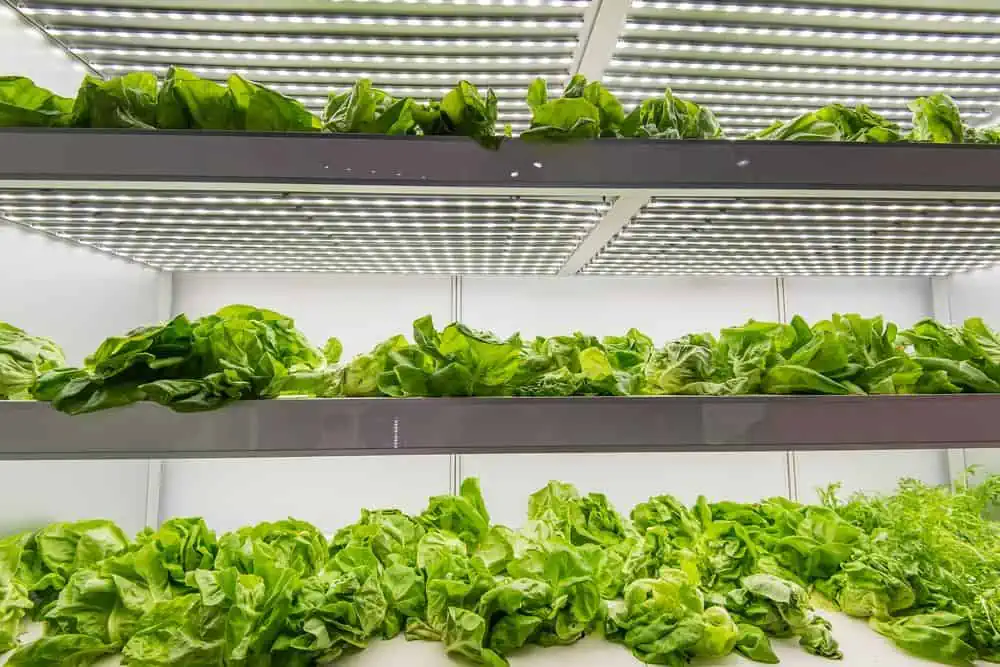
LED grow lights hold every advantage over MH, except for the initial cost to buy the lights. Even then, LEDs have come down so much in cost that the difference is no longer very large.
Energy Efficiency
LED grow lights are highly energy-efficient compared to other lighting options, including MH. The use far less electricity to generate the same output.
Lower Heat Output
LED grow lights emit less heat to generate the same output. They do not emit zero heat (as some may have you believe), but it is considerably less (around 60%).
Of course, if you live in a cold climate and you rely on the heat from your grow lights to help heat your grow space, this may be a disadvantage. But for most of us, a lower heat output saves money on cooling costs.
Customizable Light Spectrum
LED grow lights can be customized to emit specific wavelengths of light. Many even allow you to tailor the light spectrum to the specific needs of your plants using an app on your phone.
Longer Lifespan
LED grow lights have a significantly longer lifespan (up to 100,000 hours) than other types of grow lights, including metal halide. With MH, you will need to change the bulbs every few grows. With cheaper bulbs, you may even need to change them every grow.
Reasons To Get Metal Halide Grow Lights
MH grow lights are cheaper initially. If you do not have enough money in your budget for a good quality LED grow light, then an MH grow light may be your best bet, assuming you also get HPS bulbs for flowering (they use the same fixtures) or you are growing plants that do not flower (like lettuce, herbs or algae).
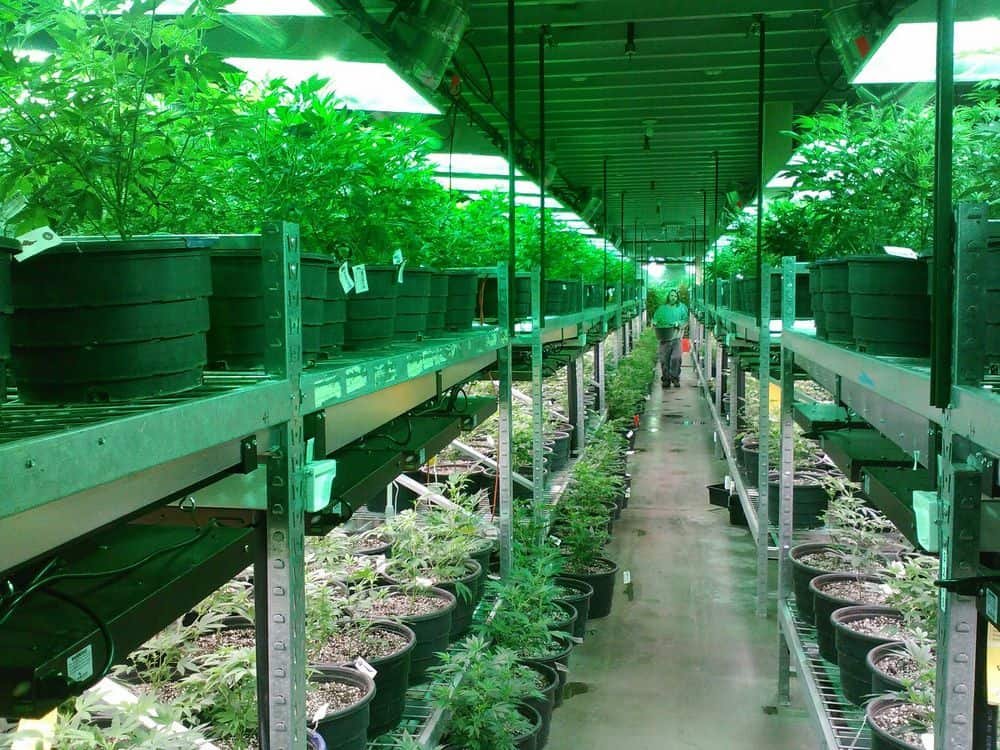
Reasons To Get LED Grow Lights
These days, LED grow lights are the best choice for almost every cannabis grower. The same goes for basically any other types of plants too. The main disadvantages of LED lights have all been eliminated or reduced over the years.
They now have a better spectrum than other types of light (assuming you buy a good full-spectrum LED light, of course) and they no longer cost much more than other types of plant lighting. They are also much more flexible, given the customized spectra available on many fixtures and the option to dim the lights down.
LED Grow Lights Vs Metal Halide: Final Thoughts
When you compare metal halide vs LED grow lights, you quickly come to a realization. It makes little sense for most growers to use MH lighting anymore.
Even if you prefer HID lights, metal halide is only the third best option. HPS is better for the whole grow (though a combination of MH for vegging and HPS for flowering is best), but the newer ceramic metal halide lights are actually the best HID light of all.
But even those don’t stack up to LED grow lights. They are now by far the best option for plant lighting. The only drawback is the higher initial cost, but even that has come down so much that is rarely going to be a deciding factor any more. That said, if you’re still unsure, we also have an article on how to choose a grow light.
Leave a Reply